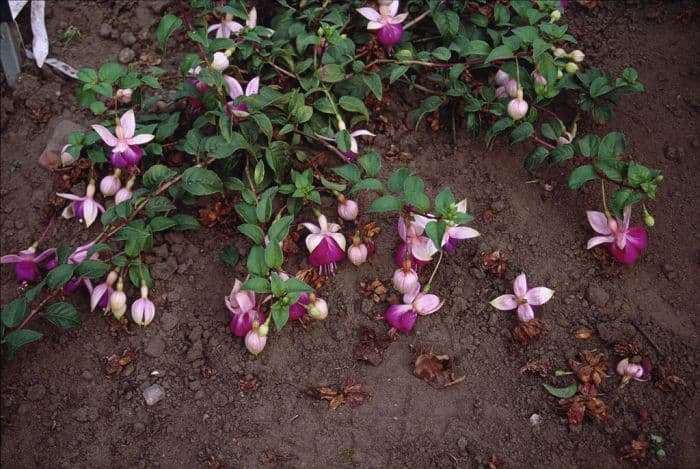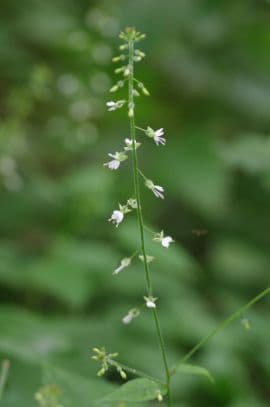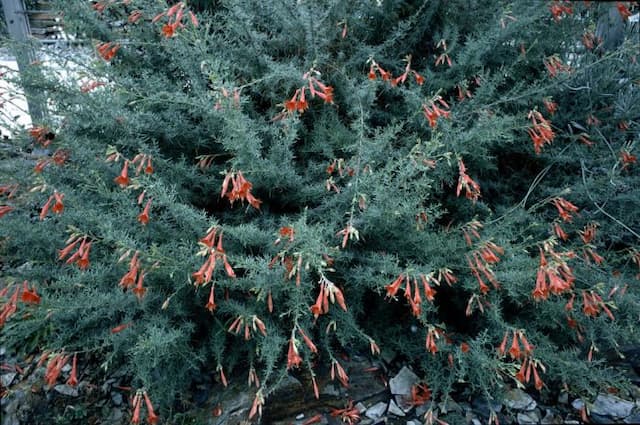Fuchsia Fuchsia 'Eva Boerg'

ABOUT
The Fuchsia 'Eva Boerg' is a visually striking, ornamental plant renowned for its graceful, hanging flowers. This fuchsia variety showcases beautiful blooms that are a true spectacle. The flowers have an intriguing shape; they appear as if dancers in elegant dresses with their petals gracefully lifted and flared. Each bloom typically consists of a deep pink to purple skirt-like outer layer with a contrasting, delicate pale pink to white inner layer that looks like a petticoat. These flowers dangle from slender stems, making them look like little lanterns, and are complemented by small, oval-shaped leaves that have a slight sheen. The leaves are usually a rich, dark green, which provides an excellent backdrop for the vibrant, dangling blooms. As a result of its charming appearance, Fuchsia 'Eva Boerg' is a popular addition to hanging baskets and container gardens, where its trailing habit can be showcased. It is also favored by gardeners looking to add a touch of whimsy and a splash of color to shaded garden areas. The blooms are abundant and can provide a long-lasting display of enchantment when properly cared for. This beautiful combination of colors and the distinctive form of its flowers make the Fuchsia 'Eva Boerg' a delightful visual delight for any plant enthusiast.
About this plant
 Names
NamesFamily
Onagraceae
Synonyms
Eva Boerg Fuchsia,Trailing Fuchsia
Common names
Fuchsia 'Eva Boerg'.
 Toxicity
ToxicityTo humans
Fuchsia 'Eva Boerg', generally referred to simply as Fuchsia, is not considered toxic to humans. It is, in fact, relatively safe and does not normally cause any symptoms of poisoning if ingested. However, caution is always advisable as individual sensitivities can vary, but generally, there are no significant toxic effects expected from the consumption of Fuchsia parts by humans.
To pets
Fuchsia, the common name for Fuchsia 'Eva Boerg', is also not typically considered toxic to pets, including dogs, cats, and horses. It is not known to cause serious illness or symptoms of poisoning if pets ingest parts of this plant. While it's always best to prevent pets from eating non-food plants as a general precaution, Fuchsias are not known to be a cause for concern in terms of toxicity.
 Characteristics
CharacteristicsLife cycle
Perennials
Foliage type
Deciduous
Color of leaves
Green
Flower color
Mixed
Height
1-1.5 feet (30-45 cm)
Spread
1-2 feet (30-60 cm)
Plant type
Shrub
Hardiness zones
9
Native area
Central America
Benefits
 General Benefits
General Benefits- Aesthetic Appeal: Fuchsia 'Eva Boerg' adds vibrant color and visual interest to gardens and landscapes with its striking purple and pink flowers.
- Hummingbird Attractor: The tubular flowers of the plant are known to attract hummingbirds, providing a natural way to enjoy wildlife.
- Shade Tolerance: This variety of fuchsia is capable of thriving in partial shade, making it ideal for garden spots that don't receive full sunlight.
- Container Gardening: Fuchsia 'Eva Boerg' is well-suited for pots and hanging baskets, allowing for versatile garden designs and balcony decoration.
- Continuous Blooming: The plant typically has a long flowering season from spring to fall, providing extended periods of color.
- Pollinator Friendly: Besides hummingbirds, it can attract other pollinators like bees and butterflies, contributing to the health of your garden ecosystem.
- Easy Propagation: Fuchsia 'Eva Boerg' can be easily propagated from cuttings, making it simple for gardeners to expand their collection or share with others.
- Manageable Growth: It has a compact and bushy growth habit, which is ideal for small spaces and avoids the need for constant pruning.
 Medical Properties
Medical PropertiesThis plant is not used for medical purposes.
 Air-purifying Qualities
Air-purifying QualitiesThis plant is not specifically known for air purifying qualities.
 Other Uses
Other Uses- Fuchsia 'Eva Boerg' can be used as an educational tool in botany and horticulture programs, illustrating plant breeding, hybridization, and the variability of flower forms.
- These plants can serve as markers in gardens or parks to signify specific trails or sections due to their distinct flowering color.
- Fuchsia 'Eva Boerg' can be a source of inspiration for artists and designers, who may use the shape and color of the flowers in their artwork or pattern designs.
- The plant can be incorporated into fashion, where its blooms are used in the design of botanical-themed fabrics or accessories.
- As a natural dye, the petals of Fuchsia 'Eva Boerg' potentially can be used in crafting for coloring fabrics or papers, though experimentation is necessary to determine the colorfastness and intensity.
- In photography, Fuchsia 'Eva Boerg' offers an attractive subject for macro photography enthusiasts, highlighting the intricacies of its blooms.
- Fuchsia 'Eva Boerg' can be used in culinary presentations, as some fuchsia flowers are edible; their vibrant colors can be used to garnish dishes and desserts.
- These plants are excellent choices for thematic gardens, such as Victorian or cottage gardens, providing an authentic historical aesthetic.
- In the floral industry, cut blooms of Fuchsia 'Eva Boerg' could be used in creating unique and exotic flower arrangements and bouquets.
- Fuchsia 'Eva Boerg' can aid in studying the effects of different environmental conditions on plant growth, making it beneficial for ecological and environmental research.
Interesting Facts
 Feng Shui
Feng ShuiThe Fuchsia is not used in Feng Shui practice.
 Zodiac Sign Compitability
Zodiac Sign CompitabilityThe Fuchsia is not used in astrology practice.
 Plant Symbolism
Plant Symbolism- Grace and Elegance: The Fuchsia 'Eva Boerg', commonly known as simply "Fuchsia", is often associated with grace and elegance due to its delicate teardrop-shaped flowers that dangle with a ballerina-like poise.
- Good Taste: The stunning appearance of the Fuchsia is symbolic of good taste and sophistication, making it a favorite in ornamental gardens and floral arrangements.
- Vibrant Energy: With its vibrant colors, Fuchsia 'Eva Boerg' represents liveliness and positive energy, infusing gardens and spaces with a sense of vibrancy.
- Confiding Love: In the language of flowers, Fuchsia can symbolize confiding love, where someone is expressing their deep and trusting affection for another.
 Water
WaterThe Fuchsia 'Eva Boerg', commonly known as the Trailing Fuchsia, prefers consistent moisture. During the growing season, water when the top inch of soil feels dry, usually about twice a week, depending on the weather conditions. Each watering should allow the water to seep deeply into the soil, ensuring the root zone is moistened. Provide roughly 16 to 24 onzes of water for potted plants, which equates to about 1 to 1.5 gallons every week for larger plants or those in the ground, adjusting for rain and high temperatures that may require more frequent watering.
 Light
LightTrailing Fuchsia thrives in bright, indirect light with protection from the harsh afternoon sun. A spot that gets morning sunlight and shade in the afternoon is ideal. Ensure it receives at least a few hours of gentle sunlight each day.
 Temperature
TemperatureThe ideal temperature range for Trailing Fuchsia is between 55°F and 75°F. These plants can tolerate temperatures as low as 40°F, but frost can be harmful. They should be protected or brought indoors if temperature drops close to freezing.
 Pruning
PruningPruning Trailing Fuchsia helps to maintain its shape, encourage bushier growth, and remove dead or diseased growth. Prune in late winter or early spring before new growth begins. Deadhead spent flowers throughout the growing season to promote continuous blooming.
 Cleaning
CleaningAs needed
 Soil
SoilFuchsia 'Eva Boerg', commonly known as Fuchsia, thrives best in a well-draining soil mix, like a combination of peat moss, sand, and loamy soil, which ensures proper moisture retention yet avoids waterlogging. The ideal soil pH for Fuchsia 'Eva Boerg' is slightly acidic to neutral, ranging between 6.0 and 7.0.
 Repotting
RepottingFuchsia 'Eva Boerg' should be repotted every two to three years to ensure they have enough room to grow and to refresh the soil, which can become compacted and nutrient-depleted over time. Spring or early summer is the best time to repot Fuchsia plants.
 Humidity & Misting
Humidity & MistingFuchsia 'Eva Boerg' prefers higher humidity levels, in the range of around 60-70%. They thrive in moist air conditions, but not too damp, as too high humidity can lead to issues with fungal diseases.
 Suitable locations
Suitable locationsIndoor
Place Fuchsia 'Eva Boerg' in bright, indirect light and high humidity indoors.
Outdoor
Hang Fuchsia 'Eva Boerg' in partial shade, shelter from strong winds.
Hardiness zone
9-11 USDA
 Life cycle
Life cycleThe life cycle of the Fuchsia 'Eva Boerg', commonly known simply as the Fuchsia, begins with seed germination, where the plant emerges from its seed under warm and moist conditions. The seedling stage follows, where the plant develops its first true leaves and establishes a root system. As the fuchsia transitions to the vegetative stage, it grows rapidly, producing lush foliage and stems. The next phase is the flowering stage, where the plant produces its distinctive and ornamental pendulous flowers, usually during the warmer months. Following pollination, the fuchsia enters the fruiting stage, setting seed within berry-like fruits that can be used to propagate new plants. Finally, in many climates, fuchsias may enter a period of dormancy during colder months, with reduced growth or even dieback, awaiting the return of warmer temperatures to resume growth.
 Propogation
PropogationPropogation time
Spring-Early Summer
Fuchsia 'Eva Boerg', commonly known as hardy fuchsia, is typically propagated through softwood cuttings in late spring to early summer when the plant is actively growing. You would take a cutting of about 2 to 4 inches (5 to 10 cm) in length from a healthy, non-flowering shoot. The bottom leaves are removed, and the cut end is dipped in a rooting hormone. The cutting is then inserted into a pot filled with a mix of peat and perlite or a similar well-draining rooting medium. The pot should be kept in a warm place with indirect light and high humidity, which can be achieved by covering it with a plastic bag or a propagator. Cuttings typically root in three to four weeks; after which, they can be transferred to individual pots and grown on until they are ready to be planted out.









